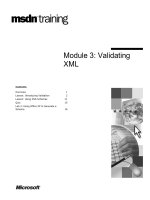Ch 3 earth science PPT
Bạn đang xem bản rút gọn của tài liệu. Xem và tải ngay bản đầy đủ của tài liệu tại đây (5.01 MB, 68 trang )
The Rock Cycle
Ag Earth Science – Chapter 3.1
3.1 Vocabulary
mineral
A natural occurring, inorganic crystalline
material with a unique chemical
composition.
rock
A consolidated mixture of minerals
igneous rock
A rock formed by the crystallization of
molten magma
sedimentary rock
Rock formed by from weathered products
of preexisting rocks that have been
transported, deposited, compacted, and
cemented.
metamorphic rock
Rock formed by the alteration of preexisting rock
deep within the Earth by heat, pressure, and/or
chemically active fluids.
rock cycle
A model that illustrates the origin of the three
basic rock types and the interrelatedness of Earth
materials and processes.
magma
A body of molten rock found at depth including
any dissolved gases and crystals.
lava
Magma that reaches the Earth’s surface.
weathering
The disintegration and decomposition of rock at
or near the Earth’s surface.
sediments
Loose particles created by weathering and
erosion of rock, by chemical precipitation from
solution in water, or from the secretions of
organisms and transported by water, wind, or
glaciers.
Rocks
A rock is any solid mass of mineral or
mineral-like matter that occurs naturally as
part of our planet.
Rocks are classified into 3 major types
Igneous Rocks
Sedimentary Rocks
Metamorphic Rocks
Interactions among the Earth’s water, air, and
land can cause rocks to change from one type to
another
The continuous processes that cause rocks to
change make up the rock cycle
When magma (molten material beneath
the Earth’s surface) cools and hardens,
igneous rocks form. Magma that reaches
the surface is called lava.
The Rock Cycle
When weathered (process by which rocks
are physically and chemically broken
down into small pieces called sediments)
sediments are compacted and cemented
together, they form sedimentary rocks.
When sedimentary rocks are subjected to
extreme pressure and heat, they change in
metamorphic rock.
The Rock Cycle
Powers of the Earth’s Rock Cycle
Heat from the Earth’s interior are
responsible for forming both igneous and
metamorphic rocks
Weathering and the movement of
weathered materials are generated by the
sun’s energy and produce sedimentary
rock.
Ag Earth Science – Chapter 3.2
3.2 Vocabulary
ignis
Latin word for “fire”
intrusive igneous rock
Igneous rock that formed below the Earth’s
surface
extrusive igneous rock
Igneous rock that has formed on the
Earth’s surface
porphyritic texture
An igneous texture consisting of large
crystals embedded in a matrix of much
smaller crystals
granitic composition
A compositional group of igneous rocks
that indicate a rock is composed entirely of
light-colored silicates, mainly quartz and
feldspar
basaltic composition
A compositional group of igneous rocks
indicating that the rock contains
substantial dark silicate minerals and
calcium-rich plagioclase feldspar
andesitic composition
A composition of igneous rocks lying
between felsic and mafic









